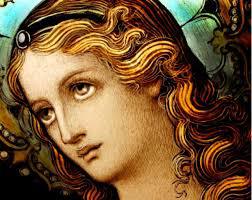By Tom Quiner

The Immaculate Conception
Have you noticed something odd about the Bible? It makes no reference to the existence of the ‘Bible’ … and yet it exists.
I reference this oddity in light of a question from a Quiner’s Diner reader on the subject of Mary’s Immaculate Conception. His question:
“Is there a scripture that talks about Mary having been saved from her sin before she was born?”
The quick answer is yes and no, the same answer we’d give if the question were:
“Is there a scripture that talks about the doctrine of the Holy Trinity?”
Yes and no. Although Catholicism and Protestantism are united in their belief in the Holy Trinity, sacred scripture doesn’t directly reference the term, just as it doesn’t directly reference the term “Immaculate Conception” in describing Mary.
So how are we supposed to figure this stuff out? The Bible tells us how in 2 Thess. 2:15 when St. Paul writes:
“So then, brethren, stand firm and hold to the traditions which you were taught by us, either by word of mouth or by letter.”
St. Paul mentions it again elsewhere in the same letter (2 Thess. 3:6):
“Now we command you, brethren, in the name of our Lord Jesus Christ, that you keep away from any brother who is living in idleness and not in accord with the tradition that you received from us”
And he mentions it again in a different letter, 1 Cor. 11:2:
“I commend you because you remember me in everything and maintain the traditions even as I have delivered them to you”.
In other words, Christian Truth is conveyed by Tradition, “either by WORD OF MOUTH or by LETTER [that is, written word, aka the Bible or Sacred Scripture].
Again, writing this time to Timothy (2 Tim. 2:2), he instructed him to pass on this Sacred Tradition to others:
“[A]nd what you have heard from me before many witnesses entrust to faithful men who will be able to teach others also”
I know I belabor the point, but it’s an important one, because Jesus didn’t tell his disciples to write everything down He said and did, but He did command them to go out to the world and teach it:
“Go therefore and make disciples of all nations, baptizing them in the name of the Father and of the Son and of the Holy Spirit, and teaching them to obey all that I have commanded you. And remember, I am with you always, to the end of the age.” (Matt. 28:19-20)
And how is that to be accomplished? Through Sacred Tradition and written scripture (which wasn’t formalized until the 4th century). Christ is with us always through the Holy Spirit who infallibly guides His Bride, the Church, through the office of Peter’s direct successors.
It took 4 centuries before the doctrine of the Holy Trinity was formalized by the Church, and it took 18 centuries before the doctrine of Mary’s Immaculate Conception was formally recognized by Pope Pius IX in 1854.
And yet scripture lays the groundwork for both. Let’s look at what 1 Chronicles 15:14 has to say on the subject:
“So the priests and the Levites consecrated themselves to bring up the ark of the LORD God of Israel.”
The ark carried the Word of God, which demanded sanctity and purification of those honored to carry it. And, as we know from the first five verses of the Gospel of John, Christ is the Word:
1 In the beginning was the Word, and the Word was with God, and the Word was God. 2 He was with God in the beginning. 3 Through him all things were made; without him nothing was made that has been made. 4 In him was life, and that life was the light of all mankind. 5 The light shines in the darkness, and the darkness has not overcome[a] it.
So Mary was the new ark of the covenant.
She was the One honored to carry the Word.
Just as purity and grace were necessary to carry the Old Testament ark, so it was for the New Testament ark, which was confirmed when the angel, Gabriel visited Her, as recorded in Luke 1:28:
“Hail, full of grace, the Lord is with you.”
Christian theologian, Jason Evert, explains the significance of this phrase:
“Since this term is in the perfect tense, it indicates a perfection of grace that is both intensive and extensive.
This means that the grace Mary enjoyed was not a result of the angel’s visit, and was not only as “full” or strong or complete as possible at any given time, but it extended over the whole of her life, from conception onward.
She was in a state of sanctifying grace from the first moment of her existence to have been called “full of grace.”
There are many more biblical references to Mary’s Immaculate Conception, but let’s look at just one more, found in Genesis 3:15:
“And I will put enmity between you and the woman,and between your offspring[a] and hers; he will crush[b] your head, and you will strike his heel.”
Mary’s offspring? Jesus.
The only way to crush the serpent’s head was to be sinless, so this passage can’t refer only to Eve, who colluded with the serpent. It also refers to the new Eve, Mary, who was full of Grace, and who, unlike Eve, said YES to God where Eve said NO.
Eve’s offspring, Cain, Abel, and Seth, didn’t crush the serpent’s head; but Mary’s did: Jesus. So this Genesis passage surely refers to Mary, too.
The Bible never said that Sacred Scripture was the only source of determining theological Truth. But it does say that Sacred Tradition is also such a source.
Nonetheless, the Bible is peppered with clue after clue of the Immaculate Conception, which the Holy Spirit revealed to mankind over time.
Advertisements Share this:




